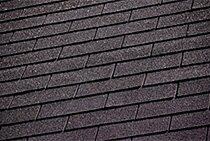What is emissivity?
 |
A thermal infrared (TIR) camera does not actually detect heat (i.e., 'true-' or 'kinetic-temperature') the same as a thermometer does. Instead, it detects the amount of TIR radiation emitted from a surface which is referred to as 'radiant temperature'. Fortunately, there is a well known relationship between a material and its ability to absorb and emit TIR radiation known as emissivity. Emissivity values range from 0 (shiny mirror) to 1.0 (blackbody) for different materials. Most organic, painted, or oxidized surfaces have emissivity values between 0.7 and 0.95. Therefore, if we know the emissivity value for a specific roofing material (Fig 9) such as asphalt, cedar, cement, rubber or metal shingles, we are able to combine it with its corresponding radiant temperature (defined by the TIR camera) to create a true kinetic temperature for each roof top. These true temperature values will then be used to determine the waste heat and HEAT Score for every house in the city. |
| Fig 9. Asphalt Shingles - one of the most common roof material types |